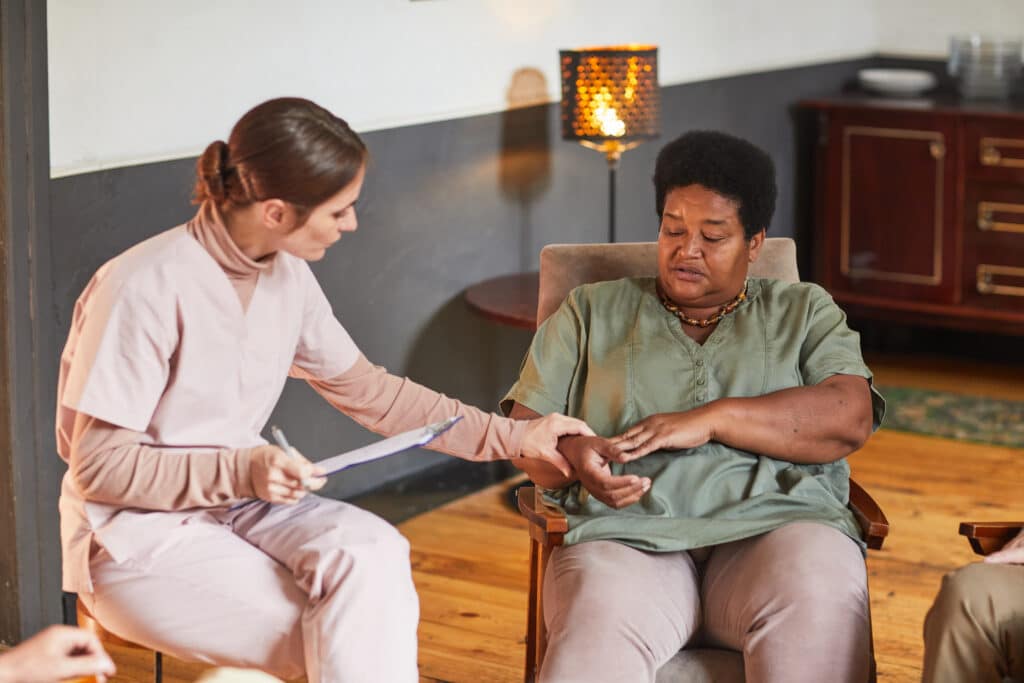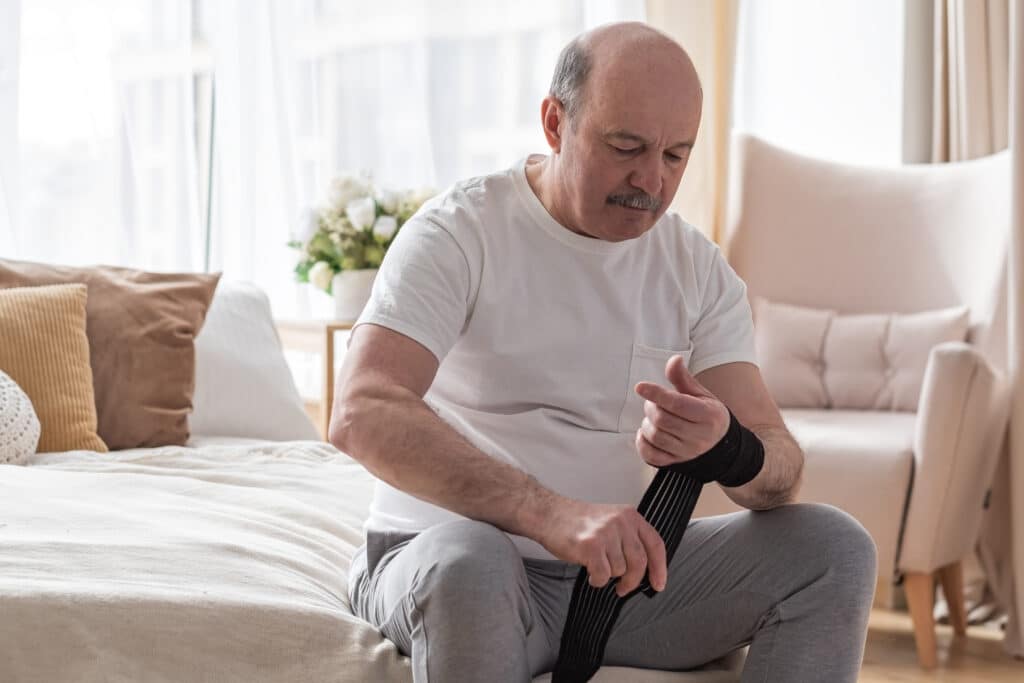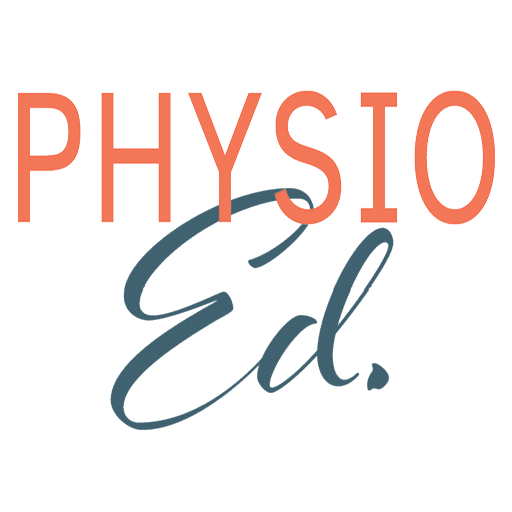Whether it’s a ping of shooting pain down your leg or numbness and tingling in your hand, nerve pain can be frustrating and uncomfortable.
In this article, we’ll take a look at what nerve pain is, what causes it and how physical therapy for nerve pain can help to lessen or even relieve symptoms.
What are the causes of nerve pain?
Nerves (also known as neurons) travel throughout the body carrying information about sensation, muscle movement, and pain to and from the brain and spinal cord.
Nerve injury can be caused by compression, stretching, or cutting into the actual nerve fibers. Specifically, nerve damage can result from trauma, overuse injuries, postural impairments, or other neurodegenerative conditions. Some nerve injuries are easier to heal, while others may require further medical attention. (1)
Nerve injury can result in pain, muscle weakness, or loss of sensation. Depending on the type of nerve cells that were damaged, different symptoms may arise.
Types and locations of nerve pain
Nerve pain and other symptoms can come in many shapes and sizes: it can present as sharp or ‘electric’ pain, pins & needles, burning, or hypersensitivity. Since every part of your body contains different varieties of nerve cells, pain can arise anywhere in the body.
The central nervous system consists of the brain and spinal cord, while the peripheral nervous system innervates the rest of your body.
Nerve pain most commonly occurs in the extremities: the arms, legs, hands, and feet.
Because the nerves carry electrical signals back and forth from the central nervous system, the hands and feet are the farthest that peripheral nerves have to travel. They are also the least protected and most distant areas of the body, which makes them more susceptible to peripheral nerve injury.
Healing from nerve pain
If you have been diagnosed with nerve pain, you may be wondering whether nerve damage can be repaired.
It depends.
Every nerve injury will be different, and recovery will vary depending on the nature of your injury and the intensity of damage to the nerve.
Sometimes acute nerve pain can be relieved within weeks, while other times the pain can be more chronic and severe. On average, nerve repair and recovery can take anywhere from six weeks to six months depending on how the injury occurred. (2)
It is important to see a professional to determine the cause of your pain, and physical therapy is one of the most frequently recommended treatments for nerve pain. Central or peripheral nerve injuries require different types of treatment, and physical therapists (or your doctor) can help get to the bottom of your pain so you can receive the best possible treatment to help heal damaged nerves.

Why use physical therapy for nerve pain?
A physical therapist can be a valuable resource as your nerves heal. They can help you restore function through a variety of therapeutic treatment methods from your initial diagnosis onward.
Some of these methods may include prescribed exercise to rebuild muscle strength, stretching or soft tissue massage to treat scar tissue, or range of motion exercises to improve movement patterns for the affected limb. Core stabilization exercises and balance methods like tai chi can also help those struggling with more generalized peripheral neuropathy. (2)
Certain strengthening exercises can help if your nerve injury is a result of a muscle imbalance or if weak muscles are altering your posture or causing joint instability. Using carefully targeted exercises, a physical therapist can help you make your joints stronger and more stable in order to lessen your pain.
If the cause of the nerve pain is tight muscles or tendons, stretching specific joints and tissues can allow the nerve more room to move. Additionally, keeping your joints mobile can prevent further injury or nerve damage. For example, physical therapy for sciatic nerve pain can involve stretching the glutes and hamstrings (3).
A physical therapist may also use soft tissue massage to release muscle tension. This can allow a nerve to have more room to move and glide in the path that it is supposed to and decrease some tension on the nerve.
Similarly, manual therapy can also be used as a desensitization technique. This can help if your nerves have become unusually sensitive to touch. Introducing light and firm touch to sensitive areas can help to get nerves used to interpreting what is painful and what is not.
Physical therapy should be one of the first lines of defense for neuropathic pain. It’s accessible, inexpensive, and has many other health benefits. Starting a home exercise routine can help to manage some varieties of peripheral neuropathy symptoms, and a physical therapist can help you get started on your path to pain relief. (4)
Benefits of physical therapy versus other treatments
While prescribed exercise has been proven to lessen the intensity of neuropathic pain, other treatments, like high doses of pain medication or nerve surgery, can have some harmful side effects. Medications such as opioids can be costly, addictive if used long-term, and may have other adverse side effects. (2)
Research shows the best approach is a combination of treatments. This might include medication alongside physical therapy, or even cognitive therapy in certain cases. It is important to take a multidisciplinary approach for more chronic and severe cases of nerve pain, since there is not a single sure-fire solution. (5)

Other symptoms & treatment options
Dealing with nerve pain, especially chronic pain, can have an emotional impact on you, too. It is common to develop sudden depression or anxiety when experiencing chronic pain. Sleep disturbances may also result from high pain intensity which can impact your mental health, work, and quality of life. (5)
For these non-physical symptoms, seeking care from a qualified mental health practitioner can help. Learning to manage and process these emotions in a productive way can help to improve your outlook as you navigate through your pain.
Conclusion
Nerve pain can be frustrating and debilitating, but you can often find relief in a variety of treatments. Research recommends a combination of guided exercise, medication, and occasionally mental health intervention.
Physical therapy can help manage symptoms, decrease pain, and improve overall physical and mental health.
If you are experiencing pain, don’t hesitate to reach out to your doctor or your friendly neighborhood physical therapist. Diagnosing and treating your pain early can mean preventing more discomfort later.
References
- Nerve Injuries – OrthoInfo – AAOS. (n.d.). OrthoInfo. Retrieved from https://orthoinfo.aaos.org/en/diseases–conditions/nerve-injuries/
- Menorca RM, Fussell TS, Elfar JC. Nerve physiology: mechanisms of injury and recovery. Hand Clin. 2013 Aug;29(3):317-30.
- Pei, J. (2021, October 25). Exercise for Neuropathic Pain: A Systematic Review and Expert Consensus. Frontiers. Retrieved December 21, 2022, from https://www.frontiersin.org/articles/10.3389/fmed.2021.756940/full
- Dahlhauser, OTR/L, OTD, S., & Boyd, PT, DPT, S. (2022, January 29). Staying Active with Peripheral Neuropathy. Foundation for PN. https://www.foundationforpn.org/staying-active-with-peripheral-neuropathy/
- Bernetti A, Agostini F, de Sire A, Mangone M, Tognolo L, Di Cesare A, Ruiu P, Paolucci T, Invernizzi M, Paoloni M. Neuropathic Pain and Rehabilitation: A Systematic Review of International Guidelines. Diagnostics (Basel). 2021 Jan 5;11(1):74.









